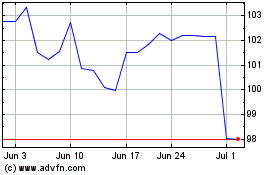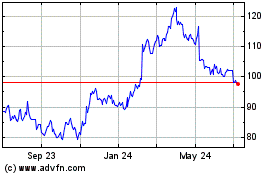MIAMI—Hurricane Matthew weakened Friday morning to a Category 3
storm as it neared Florida's Atlantic coast but still threatened to
cause devastating damage on its northern march along the coast to
South Carolina.
The National Hurricane Center said at 5 a.m. EDT that Matthew's
maximum sustained winds were 120 miles an hour, with
hurricane-force winds extending 60 miles out from the center of the
storm, which was expected to bring pounding rain and surges to
coastal areas.
Matthew's projected path shifted slightly to the east, holding
out the possibility that the storm's center will never make
landfall and instead skirt the coastline.
The hurricane's western eyewall is approaching Cape Canaveral,
near the Kennedy Space Center. Hurricane conditions are expected to
batter central Florida Friday morning, according to the hurricane
center. Before dawn, a buoy off Cape Canaveral reported a gust of
78 miles an hour, the center said.
"We are going to have a catastrophic storm," said Florida Gov.
Rick Scott at a briefing Thursday. "We have not had a storm like
this on the East Coast in a long time."
The storm already has left death and destruction in the
Caribbean. At least 283 people were killed in Haiti, with six
deaths in other countries linked to the storm, according to the
Associated Press.
Mr. Scott urged residents in areas under evacuation orders to
leave immediately. "This storm will kill you," he said, "time is
running out."
At least 340,000 electricity customers in Florida were without
power early Friday morning, according to utilities in the area.
They included about 100,000 customers knocked offline in Brevard
County, an area east of Orlando that is home to Florida's Space
Coast and many aerospace facilities.
A hurricane warning was in effect for much of Florida's eastern
coast, from Jupiter Inlet in northern Palm Beach County to the
South Santee River in South Carolina, north of Charleston. The
governors of Florida, Georgia and the Carolinas declared states of
emergency.
In Georgia, Gov. Nathan Deal ordered a mandatory evacuation
Thursday for all coastal areas south of I-95. Evacuation routes
leading to hotels, shelters or friends and family were crowded into
the night as people poured north into Middle Georgia and
Atlanta.
Most of Chatham County, with a population of 278,000 and home to
Savannah, the state's third largest city, was put under the
evacuation order. The Chatham County Emergency Management Agency
warned people needing help leaving that all public transportation
out of the county would stop by noon Friday.
The Georgia Ports Authority, which operates some of the East
Coast's busiest ports at Savannah and Brunswick, Ga., closed
operations in anticipation of the storm.
South Carolina Gov. Nikki Haley expanded the list of communities
under evacuation orders to additional counties along the eastern
coast. She said at a Thursday evening briefing that 280,000 people
had evacuated.
Asked about South Florida largely escaping the brunt of the
storm, Dennis Feltgen, spokesman at the National Hurricane Center
in Miami, said Friday morning that the center now is monitoring the
Cape Canaveral area where the storm is headed. "Our focus is ahead,
not behind," he said.
More than 1.5 million Floridians are in areas designated for
either mandatory or voluntary evacuations, stretching from the Fort
Lauderdale area in the south to the Jacksonville area in the north.
Mandatory evacuation orders are focused on portions of that
coastline, from Palm Beach County to Nassau County.
Mr. Scott said the areas that could feel the fiercest winds
include Volusia County, home to Daytona Beach, and Brevard County,
which includes Cape Canaveral.
Mr. Scott warned that Matthew could deliver 4 to 8 inches of
rain, and in some areas up to 12 inches. He said a storm surge
could reach 5 to 9 feet.
Mr. Scott said he had activated a total of 3,500 National Guard
members to help preposition resources for the storm, evacuate
people and conduct search-and-rescue work in the aftermath.
President Barack Obama signed an emergency declaration for
Florida and South Carolina because of the hurricane, the White
House said. The Department of Homeland Security's Federal Emergency
Management Agency began moving resources closer to potentially
affected areas. Mr. Scott said he had requested water, food, tarps,
pumps and generators from the federal government.
Brent Diaz, a 44-year-old pilot for United Airlines, hunkered
down in his West Palm Beach home, about 15 miles from the coast,
with his wife, Annelle, and their 4-year-old son, also named Brent.
Mr. Diaz, who has lived in Florida since 1989, weathered Hurricane
Andrew while living in Miami and doesn't expect this storm to be as
bad. He stocked up on water and nonperishables—plus coloring books
for his son—and planned to spend the night with his family in an
inner room in their home that doesn't have windows.
"I think the worst part will be dealing with no electricity and
water for days afterwards," he said. "And losing all the food in
the fridge."
In Florida, Mr. Scott ordered state offices to be closed on
Thursday and Friday in 26 counties. Schools and universities in
affected areas also will be closed those days.
Airlines have been canceling flights to and from Florida
airports in anticipation of the storm.
Walt Disney Co. said it would close its four Orlando theme parks
at 5 p.m. Thursday and keep them closed through Friday. The parks
normally close at various times, with some staying open as late as
midnight.
A much-anticipated college football game also fell victim to the
storm. Louisiana State University's Saturday game at the University
of Florida in Gainesville, Fla., a showdown between two traditional
powerhouses, was postponed. It is unclear if they will be able to
find another date to play the game.
Jon Kamp and Cameron McWhirter contributed to this article.
Write to Arian Campo-Flores at arian.campo-flores@wsj.com
(END) Dow Jones Newswires
October 07, 2016 08:45 ET (12:45 GMT)
Copyright (c) 2016 Dow Jones & Company, Inc.
Walt Disney (NYSE:DIS)
Historical Stock Chart
From Mar 2024 to Apr 2024

Walt Disney (NYSE:DIS)
Historical Stock Chart
From Apr 2023 to Apr 2024
